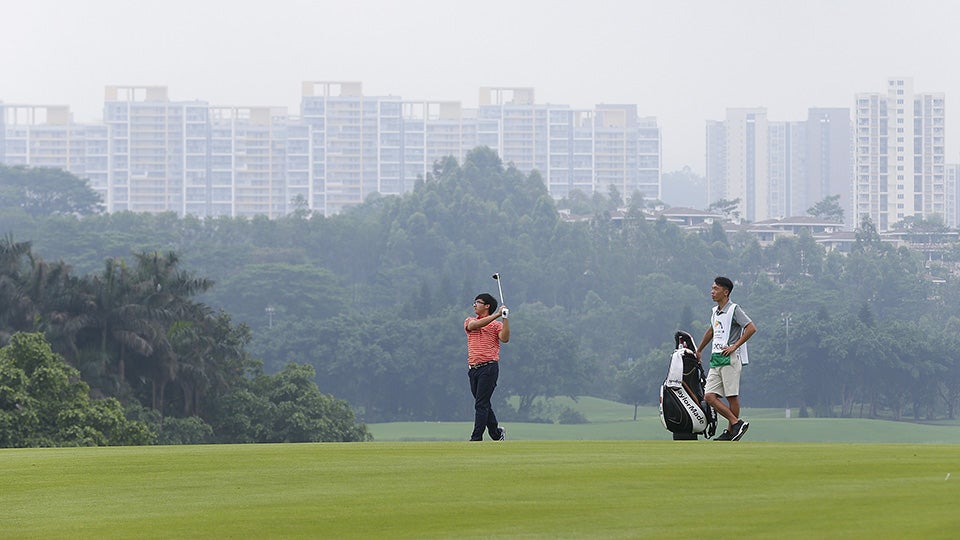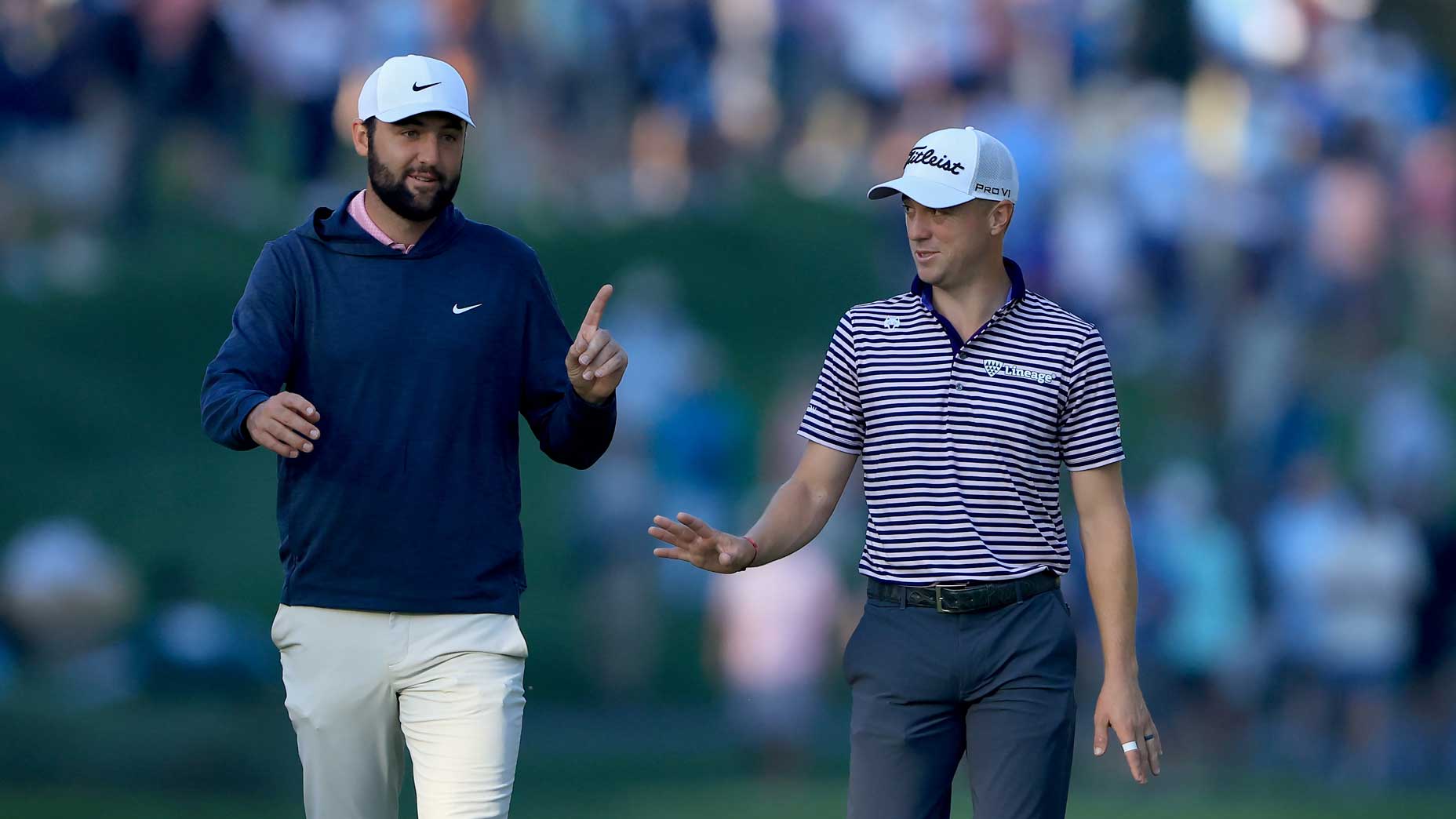This article originally appeared on Fortune.com.
Marty Dou knew at 17 years old that he should turn professional. He had been skipping half his high school classes to play, with his parents’ blessing, and by then his game was good enough to keep up with the pros.
At maybe 5-foot-9 and 150 pounds, Marty (his given name is Zecheng, but everybody calls him Marty) looks smaller than your typical pro golfer. But his size belies a swing so aggressive that even Bubba Watson, the PGA Tour’s hardest swinger, took notice at a tournament in Shanghai last year where the two played together—and where Marty finished higher than stars Adam Scott and Hideki Matsuyama.
“He has no fear,” Watson marveled. “We don’t often see an Asian-born player swinging that hard.”
Compliments from a two-time Masters winner aside, Marty, now 19, is currently the best golfer playing in China—and could soon become the first mainland Chinese golfer to compete at the top global level. He spent five years of his childhood in Canada, but he’s skipping the tried-and-true route taken by other Asian golf stars to the pros of enrolling in a U.S. college before playing junior tours in America. Friends told him stories about American college nightlife, with its drinking and hookups. His dad, a day trader, thought he needed quiet practice in China. “I’d skip school,” Marty says, laughing. “I’m too tempted by parties.”
Luckily for him, he didn’t have to leave China for a shot at golf’s biggest stage. Since 2014, the PGA, the world’s most prominent golf association, has run PGA Tour China Series, a professional league that gives promising young players a shot at graduating to higher competition in the U.S. It’s analogous to Double A minor league baseball in America: Players can put in a couple of years in China and—if they perform well enough—earn an automatic berth into another league that’s one rung below the PGA Tour. The China Tour, in turn, offers golf something it desperately needs: better access to the enormous and growing middle class that makes the country a huge growth opportunity for the sport.
Hard-swinging Marty has already won four of the nine tournaments played this season. He’s guaranteed of moving to the next level in the U.S. next year, where he will get his shot to become the first golfer from the People’s Republic of China to play full-time on the PGA Tour. Whether golf can rise as quickly in China as Marty has is a question with multibillion-dollar stakes.

Maybe you’ve heard that golf is big in China. That’s true up to a point, but “big” is relative.
In a country of 1.4 billion, the potential for the sport is certainly as vast as anyone’s imagination. Estimates of the number of Chinese golfers fall around 1 million, a small fraction of the 24 million who play in the U.S. If just 2% of China’s population played, up from less than 0.1% today, China could become a $2-billion-a-year market for golf products. That would be a godsend for an industry whose growth has sputtered in the U.S. and Europe, where manufacturers like Nike and Adidas are getting out of the golf-equipment business, and courses are closing.
China offers what no other place in the world can: a population that’s growing rapidly more affluent and thinking about golf for the first time. Already, golf teachers have flocked here from Europe and the U.S., charging $600 a lesson, and driving ranges are crowded with first-time players.
But the political, economic, and cultural constraints holding golf back in China run deep. President Xi Jinping’s antigraft campaign has targeted the sport for the past three years, in part because golf courses became a favorite rendezvous for corrupt officials. The heightened scrutiny led to dozens of courses being shut, a phenomenon that threatened to suffocate PGA Tour China in its infancy.

Even before the political winds shifted, golf had disadvantages in China. Land is scarce, and despite a building spree since 2000, the country has only about 600 courses (the U.S. has 15,000). Virtually none are the type of cheap, municipal links that cater to beginners. Almost every course is a private club located far outside the city center, behind closed gates manned by security guards. A round during the weekend pushes $200 or more, four or five times the norm in the U.S.—in a country where the typical urbanite has only about $5,000 a year in disposable income.
The result is that China’s beginners are the richest 1% of society, not exactly the ideal base from which to expand a sport’s popularity. Then again, you could have said the same about the sport’s clientele in America during the gilded 1920s, just before the pastime caught fire. To Greg Gilligan, head of the China Tour, the PGA has to start somewhere. “The Chinese consumer is aspirational,” he tells Fortune during an interview in the tour’s small, new Beijing office, where today it’s just the receptionist and him. “Think of someone moving up in disposable income. I think about the woman walking down the street, with the Prada purse, the Gucci shirt, the Starbucks in one hand and iPhone in the other. What’s next?”
Gilligan hopes what’s next is a shiny new driver. His responsibility extends beyond running the league: It’s his job to convince millions of Chinese that golf is a hobby they should start watching, loving, and maybe even playing. He wears a calm demeanor and a closet’s worth of rotating PGA Tour golf shirts. He spent almost 14 years in China for McDonald’s and four years chairing the American Chamber of Commerce in China before joining the PGA. (His own game? “Not great. Everyone thinks we get on the course a lot. Not the case.”)
When Gilligan started running the PGA’s China business in 2013, the outlook was bright. The number of Chinese golfers had tripled since 2000. Missions Hills, which hosted the first PGA-affiliated tournament in China in 1995, had expanded into the world’s largest golf complex, with 12 courses outside Shenzhen.
China had even experimented with a small professional league, called the Omega Tour, named for the Swiss watch brand that sponsored it. That tour had a short run, lasting four years before folding in 2009. But the PGA—and the state-run China Golf Association (CGA), which requires any foreign golf investor to join it as a partner—had a chance to learn from that tour’s mistakes. Most notably, the Omega had allowed only Chinese golfers to compete. That hurt it with audiences, but also with would-be competitors. China’s golfers needed better competition, and in a closed league, they couldn’t earn the world ranking points they needed to enter international tournaments.
(MORE: Chinese Government Lifts Golf Ban for Communist Party Members)
As the PGA began negotiations with the CGA, there was a growing sense in China that a foreign-run league would crowd out Chinese golfers. The wolves are coming, Chinese critics said. So the state-run group insisted on three requirements, recalls Shao Hua, a golf promotion manager who helped negotiate on behalf of the CGA: a financial guarantee, world ranking points, and no less than half the tour players to be Chinese nationals.
The two sides met at the 2013 Masters in Augusta, Ga., and later that year in Ohio. The CGA ultimately got a PGA league in China that’s the same as the league’s other junior “mini-tours” in Latin America and Canada—an open meritocracy for the world’s wannabe pros. The CGA didn’t win on its insistence that half the players be Chinese, but it turned out it didn’t need to. In competition so far, the Chinese have outrun the foreign wolves. In 2015, four of the top 10 players in the league’s year-end money rankings were Chinese. “For the Chinese side,” Shao says with a grin, “of course, 10 out of 10 would be good.”
Gilligan, like many, predicts that China will be golf’s next breakout country for pro golfers. Following the lead of Japan in the late 1980s and later Korea, which now has 14 players on the PGA Tour, China “will definitely have double digits” competing at the top level, he says. Marty Dou is part of the new generation of Chinese golfers who grew up with swing coaches, parents who bankrolled their tournaments, and teachers who didn’t mind them skipping school. He was able to join the Shanghai tournament and compete with the likes of Watson and Scott because Chinese professionals got slots that an earlier generation could only wish for.
***
PGA Tour China is also benefiting from a key recent rule change that gave young U.S. and European talent an incentive to play in places like Chongqing and Nanjing. In 2012 the PGA Tour dropped its Qualifying School tournament; after that, the PGA’s lower-level tours became a necessary stop for many up-and-comers. Today the Chinese tour has middle-age Chinese with homemade swings who started playing golf late in life, Koreans with picture-perfect swings, and big Americans fresh from college. Often there are players from five continents in the field.
Charlie Saxon traveled from Edmond, Okla., to China this year. Having put on 40 pounds since his freshman year in college so he could bomb his drives farther, the 23-year-old’s back is as wide as a mixed martial arts fighter’s. “For better or for worse—and for worse for me and other guys—you can’t qualify directly for the PGA Tour anymore,” says Saxon. Instead, players must first play on the second-highest level, the Web.com Tour, before they can reach the top level. Playing on affiliated junior tours like China’s allows high finishers to earn spots on the Web.com Tour in the U.S. without undergoing all of that tour’s rigorous qualifying tournaments.
Saxon, who ranks second on the China Tour’s money rankings, is likely to qualify for the Web.com circuit next year. In the meantime, the China Tour isn’t without hardship. Some struggle in a foreign land where the comforts of home are far. “No one wants to be here, but we got to be,” says Callum Tarren, 25, from Darlington, England. His not-quite-high-enough ranking in China means that he will likely play in another junior tour next year, maybe in Europe. Lincoln Tighe, 26, a towering Australian, says he has grown exhausted from hopping from Chinese city to Chinese city, as the oily and fried feasts served at each tournament wore him down. “I just want a chicken breast,” he says.
***
In terms of golf’s potential, the PGA’s timing in China couldn’t have been better; in terms of the country’s politics, it couldn’t have been worse.
Not long after he became China’s leader in 2013, Xi Jinping launched an anticorruption drive. Golf had become a locus of graft: In addition to being secluded and exclusive, many of China’s country clubs didn’t require members or guests to use their real names, so officials could accept the gift of a club membership without public notice.
(MORE: The Battle to Shut Down China’s Golf Equipment Black Market)
In 2014, PGA Tour China’s first year, local regulators stormed into clubs to check business licenses and membership logs. It didn’t help that courses built since 2004 were technically illegal because of a construction moratorium that was mostly ignored. One hundred courses were eventually closed by the government, and in 2015 the China Tour had to cancel two of its tournaments. (Members at one course that had been slated to host an event, CTS Tycoon in Shenzhen, lost their initial $130,000 membership fee.) China Tour organizers were left scrambling, not knowing whether the government would wipe more courses off the tournament calendar. The PGA’s schedule “coincided with uncertainty about which developers had the right paperwork in place,” says Grant Slack, head of golf events for IMG Golf in Singapore. “It was really bad in 2015, bad this spring,” says Greg Carlson, the China Tour’s executive director, who handles tournament logistics.
China’s golf promoters are “waiting for their Tiger Woods,” says a PGA official. “We can’t set our clock to stardom, but it’s going to happen.”
This year, continuing uncertainty forced PGA Tour China to announce its schedule just a couple of weeks in advance. Only 12 tournaments were scheduled; a 13th was added midseason. “It’s tough to find courses to work with us,” says Shao, the Chinese golf promoter. The head of a course in the lush southern province of Yunnan, who asked not to be named because he was nervous about local authorities’ reactions, said his club was now marketing golf as a fitness movement, to keep the government at bay. “The tough time in the past one or two years has prompted everyone to reflect,” he says.
Potential corporate backers are just as wary. In the U.S., global brands like BMW, Travelers, and John Deere build long-lasting “title sponsor” relationships with individual tournaments (the PGA Tour’s Buick Open lasted 51 years before General Motors went bankrupt). But China’s anticorruption campaign chilled such opportunities; for now, Chinese tournament title sponsors are usually the golf course and its real estate developer.
The PGA’s Gilligan thinks the challenges will melt away with time. On the bad politics: “I’ve bumped into a lot of officials who say it’s okay to be back on the course.” On the lack of courses: “Landfills!” China has lots of old ones, and the methane gas underneath means you can’t put buildings on them; golf courses would make the land useful. On wooing more Chinese to try golf: “They’re waiting for their Tiger Woods. We can’t set our clock to stardom, but it’s going to happen.”
China does have budding stars beyond Marty Dou. Li Haotong, who’s 21, won the European Tour’s Volvo China Open this year and plays full-time on the European tour. Shanshan Feng, 27, plays on the LPGA Tour in the U.S. and won the women’s bronze medal in Rio. (About a third of Chinese golfers are women, and the China LPGA tour has run a league there since 2008.) And golf equipment makers fantasize that one or more of them could break out and trigger a boom. About 10% of the adult U.S. population golfs; if China gets anywhere near that level, it would represent spectacular growth. As recently as 2011 and 2012, Callaway, Titleist, and other foreign brands were growing sales in China by 30% a year. Those gains have slowed, but as HSBC once declared, golf is moving east.

The PGA’s Carlson says a new legalization process for golf-course construction is close to being approved by the central government. Still, those rules are being shared only with local governments responsible for enforcing them—not the most enticing prospect for skittish developers. And while the government included golf among the recreational sports for the middle class that it’s promoting as an economic engine, the sport doesn’t rank very high among its priorities: In the five-year plan, it was listed between table tennis and billiards.
***
For now, golf in China remains a sport of elites and professionals. And the pros often face reminders that they aren’t yet elite. On a September day after the second round of the Ping An Bank Beijing Open, eight players stare at their Chinese buffet lunches. Saxon, the Oklahoman, has a one-shot lead, but his head is elsewhere. “Today the food options are slim,” he says, eyeing greasy noodles and vegetables soaked in soy sauce. The hotel restaurant’s manager has taken the initiative of ordering Big Macs for anyone wanting a taste of home. An Australian grabs one.
Located amid mountains an hour outside Beijing, the Ping An Open course is typical of the China Tour—tight fairways, undulating greens—and produces typical frustrations. At lunch, Chris Brown, an Australian with a baby on the way, is recounting his bad day. He lost a ball on the 11th. “I went birdie, triple [bogey], double, par, triple!”
But the best player in the league, Marty Dou, is again near the top of the leaderboard. On the first hole today, Marty’s approach shot rolled through the fringe and into the hole for eagle. “Man, the hole is like a vacuum for him. Swooomp,” says Ben Lein, an American who started his previous round hungover, played some of his best golf, and is thinking he should do it more often.
Someone asks what Marty’s chances are at the next level. Does he drive it long enough to make it in the U.S.? “He’ll be good,” says Saxon. Everyone nods. “Swooomp.”
A version of this article appears in the November 1, 2016 issue of Fortune, under the title “The PGA Tour Takes on China.”







